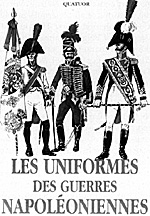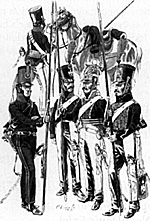 Volume 1: The French and Their Allies
Volume 1: The French and Their Allies
Authors: Bernard Coppens, Patrice Courcelle, Daniel Lordey, Michel
Pétard
Pages: 191
Illustrations: 150 color plates including 118 of French troops (with 15
plates on weapons), 22 of Confederation of the Rhine and other German
states, and 10 of other nations (including Holland, Spain, Grand Duchy
of Warsaw, Naples, Denmark)
Maps: None
Footnotes: 4 pages of notes
Appendices: None in volume 1
Bibliography: None in volume 1
Index: None in volume 1
Publisher: Editions Quatuor, 73670 Entremont Le Vieux, France; phone:
011 33 4 79 65 80 08; fax: 011 33 4 79 65 88 83
Publication Date: 1997
Binding: Cloth (hardbound)
ISBN: None displayed in volume 1
Price: 2600 FF (approx. $430 US) for 2 volumes (this was a limited
printing of 990 sets)
Summary: This is volume one of a 2 volume set with the purpose of
representing the uniforms of all the armies involved in the Napoleonic
Wars. Printing and content quality are superb. There are some
shortcomings, however, and treatment is far from complete. A major
drawback is obviously the set's hefty price tag.
Like many other Napoleonic enthusiasts, my first contact with this exciting period and its uniforms was through Liliane & Fred Funcken's excellent introductory 2-volume set published in 1968-1969, just in time for the bicentennial celebration of Napoleon's birth in 1769. Despite their mistakes and sometimes superficial overview of such a huge topic, the Funcken volumes were probably responsible for producing a modern Grande Armée of passionate enthusiasts. These books were actually the first true overview of the uniforms of all the armies involved in the Napoleonic Wars.
The publisher (Casterman of Belgium) aimed the books at the youth market and priced them accordingly. The Funcken set went into several reprints after initial success. Just a few years ago, it got another reprint in a luxurious one-volume edition.
Now, 30 years later, we are celebrating the bicentennial of the start of Napoleon's meteoric rise to power. As in the late 1960s, there is a flood of new publications, some of which are published in limited quantities and aimed at a specialist market. We should probably rejoice: a century ago the same phenomenon resulted in a great number of limited-edition classics now eagerly sought by collectors (e.g., Fallou's Garde Imperiale, Chelminski's L'Armée du Grand Duché de Varsovie).
Editions Quatuor is a very small, quality French publisher which has previously undertaken the publishing or reprinting of massive (and expensive) tomes related primarily to the Napoleonic era.
 This latest endeavor claims to present, for the first time, all the
uniforms worn by the various armies involved in the Napoleonic Wars. Two
volumes are planned. The first one devoted to the French and their
Allies was just published (December 1997). The second one covering
Napoleon's enemies is scheduled for release in April 1998.
This latest endeavor claims to present, for the first time, all the
uniforms worn by the various armies involved in the Napoleonic Wars. Two
volumes are planned. The first one devoted to the French and their
Allies was just published (December 1997). The second one covering
Napoleon's enemies is scheduled for release in April 1998.
This is obviously an ambitious task and the publisher sought the help of those military artists who are probably recognized as the best in their generation within the French-speaking world. They are:
Bernard Coppens is a Belgian artist who published a series of plates on Waterloo uniforms and contributed to various magazines. His style is crisp and somewhat academic, highlighted by a subtle use of color. Patrice Courcelle is also a Belgian illustrator. He specializes in little- known troops (such as emigré regiments) or non-French armies. In the 1980s he published a series of plates ("Those who challenged the Eagle") devoted to the Allied armies. Unfortunately, it stopped after plate 22. Some prefer his lifelike style (as does this reviewer) which also contains an exquisite amount of detail.
Michel Pétard is probably the most well-known of these four artists for his longstanding contributions both in the field of weapon technical illustrations (Aries plates) and on uniforms (in Uniformes and then Tradition magazines). His style is known for its graphic precision. Daniel Lordey is an official painter to the French army. Of the four, I found his work to be the weakest. The colors tend to be a bit too bright and the illustrations lack the same precision as the others. This harsh opinion is purely subjective and does not lessen the overall level of quality of the book which is extremely high.
Precision and beauty are indeed the key words when it comes to an overall impression of this volume. Obviously, given the topic of the first volume, there is little that a true Napoleonic aficionado will find totally new. Nor does this book appear to be the definitive reference work one might expect. On the French army, the Rousselot plates remain the undisputed classic. However, the book does manage to combine both regulation dress as well as lesser known and colorful patterns gleaned from a variety of sources (including the elusive and controversial "Marckholsheim manuscript" which hopefully someone will republish one day). There are also some odd imbalances: The carabiniers are dealt with in only one plate (combining both pre- and post-1810 dress), while the French chevau-légers get three!
Despite the number of plates, treatment of some of the French allies is somewhat superficial. This criticism may be a bit unfair as there has been no work of this quality which attempted to offer representative uniforms of all these armies. A special note must also be made for the plates on weapons. These, consistent with Michel Pétard's talents, are truly excellent.
Given the topic, the high price and the overall quality, a comparison is appropriate with Colonel J.R. Elting's excellent 2-volume Napoleonic Uniforms. Although the scope seems similar, the result is quite different. Knötel's works as collected and organized by Colonel Elting resulted in an encyclopedia. In this case, the goal from the start was to create an encyclopedia.
The second volume to be released in April may be more eagerly anticipated than this one, as the expectation is for really new or rarely seen material. The publisher plans to offer 33 plates for each of the following countries: England, Austria, Prussia and Russia. Spain, other nations and weapons will be covered in 18 plates.
Although the text is in French, this is more of a picture book. Anyone familiar with uniforms and weapons should be able to use it as a reference guide. On the other hand, as someone fluent in French, I was surprised by the lack of written information. Hopefully, volume two will provide a list of sources and relevant bibliography.
When this review appears, the publisher notes that only a few hundred sets will remain. If you are truly passionate about Napoleonic uniforms, volume one's quality may justify this set's price. (Being a limited edition may also make it a worthwhile investment, although only time will tell.)
If you want to get an idea of what the various Napoleonic armies looked like on a more limited budget, try to find a copy of the Funcken set or collect the Osprey series.
More Napoleonic Library
-
Book News 1998
On the Fields of Glory
Les Uniformes des Guerres Napoleoniennes
les Epogee Napoleonienne
Napoleon
Les Campagne de Russie 1812
Du Silex au Piston
Armes a Feu Francaises Modeles Reglementaires 1717-1836
Back to Table of Contents -- Napoleon #12
Back to Napoleon List of Issues
Back to MagWeb Master Magazine List
© Copyright 1998 by Emperor's Press.
This article appears in MagWeb (Magazine Web) on the Internet World Wide Web.
The full text and graphics from other military history magazines and gaming magazines are available at http://www.magweb.com